Chapter 10: Light reflection and refraction

What is Light?
Light is a form of energy which when falls on any object bounces back to our eyes and helps us to see the objects.
In this chapter we are going to learn about the two most important phenomena associated with light:
- Reflection of Light
- Refraction of Light
Reflection of Light:
When light falls on a polished surface it bounces back in the same medium this phenomena of bouncing back of light is known as reflection of light.

In the above image you can observe that there are two rays of light one which strikes the mirror from the source and the second that reflects back after striking the mirror. The ray that strikes the mirror from the sources is called as the Incident ray, and the ray that reflects back is known as reflected ray.
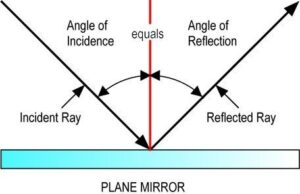
The above diagram shows three lines drawn on a plane mirror the Incident ray, Reflected ray and the red line represents Normal to the surface.
Normal: The line drawn perpendicular to the surface of mirror is known as normal.
Angle of Incidence: The angle between the normal and the incident ray is known as angle incidence.
Angle of reflection: The angle formed between the normal and the reflected ray is known as angle of reflection.
Basic terms used in the chapter:
- OBJECTS: Anything which gives out light rays either its own or reflected by it is called an object.
- LUMINOUS OBJECTS: The objects like the sun, other stars, electric bulb, tube- light etc. which emit their own light are called luminous objects.
- NON – LUMINOUS OBJECTS: The objects which do not emit light themselves but only reflect or scatter the light which falls on them, are called non-luminous objects. A flower, chair table, book, trees, etc are all non-luminous objects.
- IMAGES: Image is an optical appearance produced when light rays coming from an object are reflected from a mirror (or refracted through lens).
Types of Images:
REAL IMAGE: The image which can be obtained on a screen is called a real image. In a cinema hall, we see the images of actors and actress on the screen. So, the images formed on a cinema screen is an example of real images.
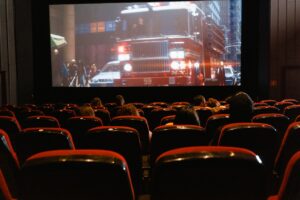
VIRTUAL IMAGE: The image which cannot be obtained on a screen is called a virtual image. A virtual image can be seen only by looking into a mirror. The image of our face in a plane mirror is an example of virtual image.

Types of Mirrors:
- Plane mirror: The mirror having plane surface is called as plane mirror

2. Convex mirror: The mirror which is thick at the center and is bulging outwards is called convex mirror.

3. Concave mirror: The mirror is thin at the center and is curved inwards.
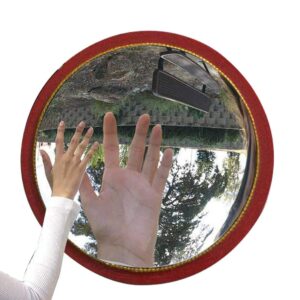
CHARACTERISTICS OF IMAGES FORMED BY PLAN:
The characteristics of images formed by plane mirrors are:
- The image of real object is always Such image cannot be taken on a screen.
- The image formed in a plane mirror is always
- The size of the image in a plane mirror is always the same as the size of the
- The image formed in a plane mirror is as far behind the mirror, as the object is in front of the
- The image formed in a plane mirror is laterally inverted e. the left side of the objects becomes the right side of the image and vice-versa.
LATERAL INVERSION
When an object is placed in front of a plane mirror, then the right side of object appears to become the left side of image; and the left side of object appears to become the right side of image. This change of sides of an object and its mirror image is called lateral inversion.
The phenomenon of lateral inversion is due to the reflection of light.
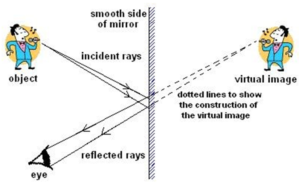
SPHERICAL MIRROR
A spherical mirror is that mirror whose reflecting surface is the part of a hollow sphere of glass. The spherical mirrors are of two types: Concave mirror and Convex mirror.
TERMS RELATED TO SPHERICAL MIRRORS
Centre of Curvature(C): The canter of curvature of a spherical mirror is the canter of the hollow sphere of glass of which the spherical mirror is a part. It is represented by letter ‘C’.PRINCIPAL FOCUS OF A SPHERICAL MIRROR
The principal focus of a concave mirror is a point on its principal axis to which all the light rays which are parallel and close to the axis, converge after reflection from the concave mirror. A concave mirror has a real focus. The focus of a concave mirror is in front of the mirror. Since a concave mirror converges a parallel beams of light rays, it is also called converging mirror.
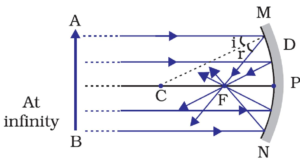
The principal focus of a convex mirror is a point on its principal axis from which a beam of light rays, initially parallel to the axis, appears to diverge after being reflected from the convex mirror. A convex mirror has a virtual focus. The focus of a convex mirror is situated behind the mirror. Since a convex mirror diverges a parallel beams of light rays, it is also called diverging mirror.
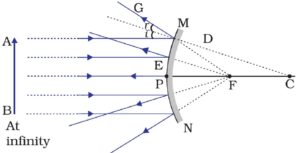
Focal Length: The focal length of a spherical mirror is the distance between its pole and principal focus. It is denoted by the letter ‘f’.
Relation between Radius of curvature and focal length of a spherical mirror
The focal length of a spherical mirror is equal to half of its radius of curvature.RULES FOR OBTAINING IMAGES FORMED BY SHPERICAL MIRRORS
The intersection of at least two reflected rays give the position of image of the point object. Any two of the following rays can be considered for locating the image.
- A ray parallel to the principal axis, after reflection, will pass through the principal focus in case of a concave mirror or appear to diverge from the principal focus in case of a convex mirror.
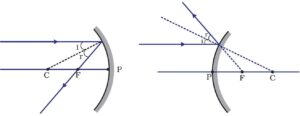
- A ray passing through the principal focus of a concave mirror or a ray which is directed towards the principal focus of a convex mirror, after reflection, will emerge parallel to the principal
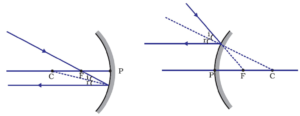
- A ray passing through the centre of curvature of a concave mirror or directed in the direction of the centre of curvature of a convex mirror, after reflection, is reflected back along the same path. The light rays come back along the same path because the incident rays fall on the mirror along the normal to the reflecting surface.

- A ray incident obliquely to the principal axis, towards a point P (pole of the mirror), on the concave mirror or a convex mirror , is reflected obliquely. The incident and reflected rays follow the laws of reflection at the point of incidence (point P), making equal angles with the principal axis.

FORMATION OF DIFFERENT TYPES OF IMAGES BY A CONCAVE MIRROR
The type of image formed by a concave mirror depends on the position of object in front of the mirror. There are six positions of the object:
Case–1: Object is placed at infinity
- When an object is placed at infinity of a concave mirror,
- Image formed is at the focus
- Nature is real and inverted, and
- Size is much smaller than the object (or highly diminished)
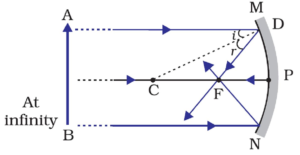
Case–2: Object is at the focus(F).
- When an object is placed at the focus of a concave mirror, the
- Image formed is at infinity
- Nature is real and inverted, and
- Size is highly magnified (or highly enlarged)
- Please note that case 1 and 2 are opposite of each other
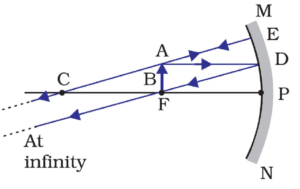
Case–3: Object is beyond the Centre of curvature(C)
- When an object is placed beyond the centre of curvature of a concave mirror, the
- Image formed is between the focus and center of curvature
- Nature is real and inverted,
- Size will be smaller than the object (or diminished)
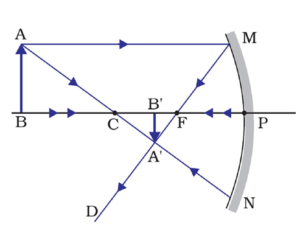
Case–4: Object is in between focus(F) and centre of curvature(C)
- When an object is placed between the focus(F) and centre of curvature(C) of a concave mirror
- Image formed is beyond the centre of curvature
- Nature is real and inverted, and
- Size is larger than the object (or magnified)

Case–5: Object is at the centre of curvature(C)
- When an object is placed at the centre of curvature of a concave mirror
- The image formed is at the centre of curvature
- Nature is real and inverted
- Size will be same size as the object
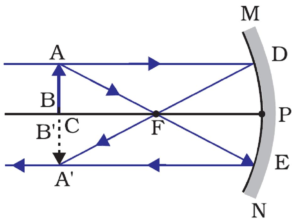
Case–6: Object is in between P and F
- When an object is placed between the pole(P) and focus(F) of a concave mirror,
- The image formed is behind the mirror
- Nature is virtual and erect and
- Size is larger than the object (or magnified)
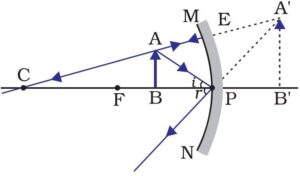
USES OF CONCAVE MIRRORS
- Concave mirrors are commonly used in torches, search-lights and vehicles headlights to get powerful parallel beams of
- Concave mirrors are used as shaving mirrors to see a larger image of the
- The dentists use concave mirrors to see large images of the teeth of
- Concave mirrors are used as doctor’s head mirrors to focus light coming from a lamp on to the body parts of a patient to be examined by the doctor.
- Concave dishes are used in TV dish antennas to receive TV signals from the distant communications
- Large concave mirrors are used to concentrate sunlight to produce heat in solar
FORMATION OF DIFFERENT TYPES OF IMAGES BY A CONVEX MIRROR
The type of image formed by a convex mirror depends on the position of object in front of the mirror. There are six positions of the object:
Case–1: Object is placed between P and infinity
- When an object is placed between pole and infinity in front of a convex mirror,
- The image formed is between the pole and focus
- Nature will be virtual and erect, and
- Size will be smaller than the object (or diminished)
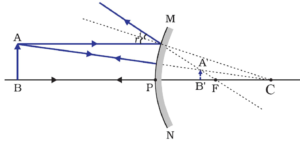
Case–2: Object is at infinity.
- When an object is placed at infinity of a convex mirror,
- The image formed is behind the mirror at focus
- Nature will be virtual and erect, and
- Size will be much smaller than the object (or highly diminished)
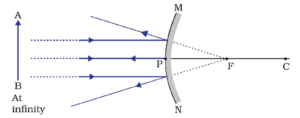
USES OF CONVEX MIRRORS
Convex mirrors are commonly used as rear-view (wing) mirrors in vehicles. These mirrors are fitted on the sides of the vehicle, enabling the driver to see traffic behind him/her to facilitate safe driving. Convex mirrors are preferred because they always give an erect, though diminished, image. Also, they have a wider field of view as they are curved outwards. Thus, convex mirrors enable the driver to view much larger area than would be possible with a plane mirror.

